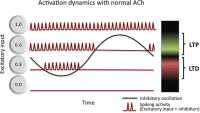Cholinergic modulation of cognitive processing: insights drawn from computational models
- PMID: 22707936
- PMCID: PMC3374475
- DOI: 10.3389/fnbeh.2012.00024
Cholinergic modulation of cognitive processing: insights drawn from computational models
Abstract
Acetylcholine plays an important role in cognitive function, as shown by pharmacological manipulations that impact working memory, attention, episodic memory, and spatial memory function. Acetylcholine also shows striking modulatory influences on the cellular physiology of hippocampal and cortical neurons. Modeling of neural circuits provides a framework for understanding how the cognitive functions may arise from the influence of acetylcholine on neural and network dynamics. We review the influences of cholinergic manipulations on behavioral performance in working memory, attention, episodic memory, and spatial memory tasks, the physiological effects of acetylcholine on neural and circuit dynamics, and the computational models that provide insight into the functional relationships between the physiology and behavior. Specifically, we discuss the important role of acetylcholine in governing mechanisms of active maintenance in working memory tasks and in regulating network dynamics important for effective processing of stimuli in attention and episodic memory tasks. We also propose that theta rhythm plays a crucial role as an intermediary between the physiological influences of acetylcholine and behavior in episodic and spatial memory tasks. We conclude with a synthesis of the existing modeling work and highlight future directions that are likely to be rewarding given the existing state of the literature for both empiricists and modelers.
Keywords: acetylcholine; attention; computational model; entorhinal cortex; memory; oscillatory interference; spatial navigation; theta.
Figures




Similar articles
-
Effects of acetylcholine on neuronal properties in entorhinal cortex.Front Behav Neurosci. 2012 Jul 24;6:32. doi: 10.3389/fnbeh.2012.00032. eCollection 2012. Front Behav Neurosci. 2012. PMID: 22837741 Free PMC article.
-
Potential roles of cholinergic modulation in the neural coding of location and movement speed.J Physiol Paris. 2016 Sep;110(1-2):52-64. doi: 10.1016/j.jphysparis.2016.09.002. Epub 2016 Sep 24. J Physiol Paris. 2016. PMID: 27677935 Free PMC article. Review.
-
Neuromodulation, theta rhythm and rat spatial navigation.Neural Netw. 2002 Jun-Jul;15(4-6):689-707. doi: 10.1016/s0893-6080(02)00057-6. Neural Netw. 2002. PMID: 12371520 Review.
-
Computational modeling of entorhinal cortex.Ann N Y Acad Sci. 2000 Jun;911:418-46. doi: 10.1111/j.1749-6632.2000.tb06741.x. Ann N Y Acad Sci. 2000. PMID: 10911889 Review.
-
How reduction of theta rhythm by medial septum inactivation may covary with disruption of entorhinal grid cell responses due to reduced cholinergic transmission.Front Neural Circuits. 2013 Oct 31;7:173. doi: 10.3389/fncir.2013.00173. eCollection 2013. Front Neural Circuits. 2013. PMID: 24198762 Free PMC article.
Cited by
-
New clues for the role of cerebellum in schizophrenia and the associated cognitive impairment.Front Cell Neurosci. 2024 May 10;18:1386583. doi: 10.3389/fncel.2024.1386583. eCollection 2024. Front Cell Neurosci. 2024. PMID: 38799988 Free PMC article. Review.
-
Causal evidence for cholinergic stabilization of attractor landscape dynamics.Cell Rep. 2024 Jun 25;43(6):114359. doi: 10.1016/j.celrep.2024.114359. Epub 2024 Jun 13. Cell Rep. 2024. PMID: 38870015 Free PMC article.
-
In vivo cholinergic modulation of the cellular properties of medial entorhinal cortex neurons.J Physiol. 2013 May 15;591(10):2611-27. doi: 10.1113/jphysiol.2012.250431. Epub 2013 Mar 25. J Physiol. 2013. PMID: 23529129 Free PMC article.
-
A Genetic Animal Model of Alcoholism for Screening Medications to Treat Addiction.Int Rev Neurobiol. 2016;126:179-261. doi: 10.1016/bs.irn.2016.02.017. Epub 2016 Mar 21. Int Rev Neurobiol. 2016. PMID: 27055615 Free PMC article. Review.
-
Memory-Enhancing Effect of 8-Week Consumption of the Quercetin-Enriched Culinary Herbs-Derived Functional Ingredients: A Randomized, Double-Blind, Placebo-Controlled Clinical Trial.Foods. 2022 Sep 2;11(17):2678. doi: 10.3390/foods11172678. Foods. 2022. PMID: 36076862 Free PMC article.
References
-
- Alkondon M., Pereira E. F., Barbosa C. T., Albuquerque E. X. (1997). Neuronal nicotinic acetylcholine receptor activation modulates gamma-aminobutyric acid release from CA1 neurons of rat hippocampal slices. J. Pharmacol. Exp. Ther. 283, 1396–1411 - PubMed
Grants and funding
LinkOut - more resources
Full Text Sources

